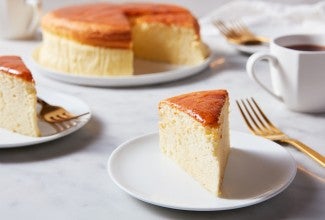Things bakers know: Why a whisk (not a spatula!) is the best tool for folding
Turns out, it’s better at incorporating beaten eggs without deflating them.


On a list of phrases that send chills down bakers’ spines, “Fold gently, being sure not to deflate the egg whites” ranks towards the top. (Other candidates include: “Carefully invert the upside-down cake”; “Fill up the water bath”; “Temper the chocolate”; and “Unmold the Bundt.”)
When you’re making a recipe that relies on whipped eggs or egg whites for lightness and structure — such as angel food cake, chiffon cake, fluffy waffles, or Japanese-Style Soufflé Cheesecake — the success of the finished product is dependent on maintaining the air you’ve whipped into those eggs. For a light, melt-in-your-mouth texture and a high, even rise, it’s important to incorporate the eggs or egg whites into the batter (or the dry ingredients into the eggs) assertively enough that your mixture is homogenous (no one wants a streak of flour or a bite of egg), yet gently enough that the air bubbles don’t burst and deflate. If they do, your baked good may turn out flat and dense — not ideal. (This can also occur with non-egg applications, like whipped cream.)
Like many bakers, I’ve always done this step with a bit of hesitance and, as I’d been taught long ago, a rubber spatula, a tool that provides the necessary leverage and flexibility to scoop all the way to the bottom of the bowl in big, sweeping motions. But all that changed when I baked Charlotte Rutledge’s Japanese-Style Soufflé Cheesecake, in which she instructs to fold in the whipped egg whites with a whisk. You heard me: a whisk.

It may seem counterintuitive to use a whisk for folding (especially if you, like me, have spent your life using a spatula), but it makes a lot of sense: A whisk may not be as flexible as a spatula, but in each stroke, you can incorporate more of the whites (and more quickly) because the points of contact are spread over all of the wires of the whisk, rather than across the two flat sides of the spatula. The whisk’s wide, open structure allows it to move through the batter with more efficiency and less direct force, which means you’re not as likely to deflate the bubbles. And the more bubbles, the lighter your finished product.
Once you’ve secured your medium or large whisk (save the mini and dough whisks for another time), use it the same way you would a spatula: Make a cutting motion down the center of the bowl, toward you, then scoop up the batter from the bottom and bring it up and over the top in a circular motion. Rotate the bowl as you work to make sure you’re incorporating the egg whites from all directions, and continue until the mixture is homogenous.
With this tip, you can cross “folding gently” off your too-scared-to-attempt list. Next up: Bundt cakes!
Cover photo by Rick Holbrook; food styling by Kaitlin Wayne.


